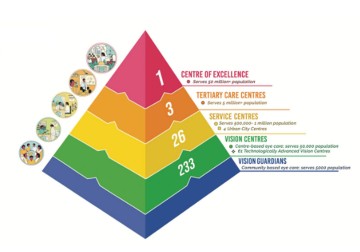Dr Gullapalli N Rao, founder Chair of the L V Prasad Eye Institute (LVPEI), discusses the values, principles, and systems that have built LVPEI. He also notes the influences and aspirations behind the LVPEI pyramid of eye care delivery, as part of the Indian Journal of Ophthalmology’s ‘Living Legends’ series.
The Vision Loss Expert Group (VLEG) notes that South Asia today has some of highest burden of vision loss and is projected to be home to over 500 million people with vision impairment by 2050. India, with its growing elderly population and the lifestyle changes of its citizens, will account for a substantial part of this burden. India is also home to key innovations that have helped ensure that eye care services reach deep into the vast hinterlands of the country. Eye hospital networks, civil society organizations, the state and national governments have all worked together to build networks of care that have had noticeable success. Their combined efforts have resulted in a decline in the prevalence of blindness from 3.60% in 2007 to 1.99% in 2019.
Starting as a tertiary eye care center in 1986, the L V Prasad Eye Institute is one of the pillars of India’s eye health success story. LVPEI offers comprehensive eye care to everyone irrespective of their ability to pay. The care offered is world-class, methodical, and delivers on its promise of value day after day, in a world where the pursuit of ‘excellence’ or ‘equity’ can seem impossible. As new generations of eye health professionals rise up, it is important for them to understand the motivations and effort behind an institution like LVPEI.
In a guest editorial in the October issue of the Indian Journal of Ophthalmology, the founder Chair of LVPEI, Dr Gullapalli N Rao, writes about the values and systems that make LVPEI unique. Dr Rao weaves his personal journey with that of LVPEI, pulling the curtain back on key aspects of the institution’s functioning. He discusses the two key systems that drive LVPEI’s success: the LVPEI eye health pyramid, and LVPEI’s ten functional arms. LVPEI’s ten functional arms—which he compares to an inter-digitated corneal endothelium—is an integrated management system that provides the organizational frame. The system brings together research, education, patient care, product development into a matrix, where interactions and information translate into outcomes and patient satisfaction. The pyramid, with its system of permanent centers in rural, peri-urban, and urban areas, builds trust and engenders health-seeking behavior in its catchment.
LVPEI has transitioned to a new management, and the article discusses plans for the future. Institutes of excellence within the LVPEI network, in partnership with others, will cater to over 150 million people. This growth and LVPEI’s learnings will fuel an integrated approach that brings together eye care and other health services to deliver universal health coverage. The editorial offers a bird’s eye-view of this unique institution and makes it a welcome addition to the IJO’s ‘Living Legends’ series. The series aims to ‘chronicle the highly inspiring lives and times of ophthalmologists who have brought about paradigm changes in the specialty, and share their life's message succinctly with [its] readers.’
‘The LVPEI model has much to offer for all those striving to deliver integrated people-centered eye care around the world,’ said Dr Gullapalli N Rao, the founder Chair of LVPEI. ‘Many visionary institutions and individuals have inspired us and have helped us change the reality of sight loss around the world. There is much more to be done, and together, we can work towards the promise of universal eye health.’
Citation
Rao GN. Institution Building: LV Prasad Eye Institute. Indian J Ophthalmol 2022;70:3440-4.
Photo credit: LVPEI eye health pyramid,



